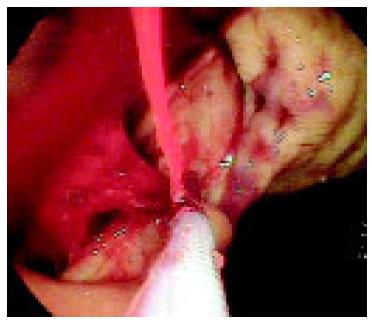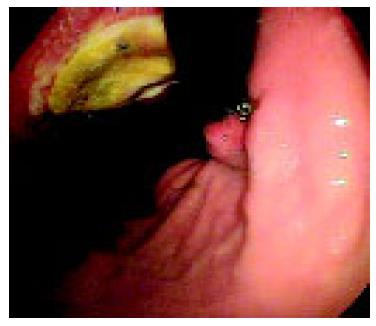Published online Jul 21, 2005. doi: 10.3748/wjg.v11.i27.4285
Revised: October 10, 2004
Accepted: October 13, 2004
Published online: July 21, 2005
A 75-year-old male with malignant lymphoma (ML) accompanied with gastric lesion was treated with combination chemotherapy. The patient produced tarry stool on the 4th d, and emergency gastroscopy showed arterial bleeding from the lesion. Hemostasis was achieved by injecting pure ethanol and using hemostatic clips. There is only one previous report on endoscopic hemostasis being effective for bleeding due to lymphoma. Since gastric bleeding causes significant mortality, endoscopic hemostasis should be considered as first-line treatment for ML patients who were treated with chemotherapy.
- Citation: Nomura K, Yamada S, Shimizu D, Okuda T, Kamitsuji Y, Yoshida N, Matsumoto Y, Wakabayashi N, Mikami K, Horiike S, Okanoue T, Taniwaki M. Successful endoscopic hemostasis for gastric arterial bleeding due to invasion of malignant lymphoma. World J Gastroenterol 2005; 11(27): 4285-4286
- URL: https://www.wjgnet.com/1007-9327/full/v11/i27/4285.htm
- DOI: https://dx.doi.org/10.3748/wjg.v11.i27.4285
Patients with stage I-II primary gastric lymphoma are commonly treated with chemotherapy alone or in combination with radiation therapy to avoid long-term sequelae after gastric resection[1,2]. Although gastrointestinal bleeding during chemotherapy has been observed in only 3% of cases[2], it is a definite cause of mortality. However, only emergency gastrectomy may be able to rescue patients with neutropenia and thrombocytopenia after chemotherapy[3].
Endoscopic hemostasis has been established as a first-line treatment for acute bleeding in all patients with peptic ulcer. Among various methods employed, injection with pure ethanol or the use of hemostatic clips is one of the most effective treatments for achieving definitive hemostasis[4-8]. However, there has been only one report describing a case of successful endoscopic hemostasis for bleeding from lymphoma in the stomach. However, this case underwent hemostatic treatment before chemotherapy[9].
Our report concerns an elderly patient with gastric bleeding due to invasion of lymphoma after standard chemotherapy. Although this patient was considered inoperable before chemotherapy, we managed to achieve hemostasis by injecting pure ethanol and using hemostatic clips.
A 75-year-old man was admitted to our hospital in January 2004 because of lumbar pain. Computed tomography detected a huge mass at the kidney and swelling of the paraaortic lymph nodes. He was diagnosed as having renal cell carcinoma with lymph node invasion and underwent surgical treatment in March. However, the swelling of the lymph nodes was histologically diagnosed as diffuse large B-cell lymphoma (DLBCL), and because 67Ga-citrate scintigraphy showed uptake at the stomach, we performed upper gastrointestinal endoscopy. An ulcerative lesion was detected in the upper body (Figure 1), which, although suspected of being invasion of lymphoma, a biopsy sample showed to be a benign ulcer. Because there were no other signs of lymphoma, the patient was treated with interferon therapy for renal cell carcinoma as adjuvant therapy. Omeprazole and cimetidine were administered for the gastric lesion. After 2 mo, multiple superficial lymph node swelling was observed. Biopsy of the cervical lymph node indicated recurrence of DLBCL, but because our patient was considered inoperable, we started CHOP therapy (cyclophosphamide, adriamycin, vincristine, and prednisolone) on 6th July. However, the patient produced massive tarry stool on d 4, resulting in a drop in the hemoglobin level to 44 g/L. Emergency endoscopy was performed that detected arterial bleeding from the ulcerative lesion in the upper body (Figure 2).
The condition had not changed since the previous examination in spite of the treatment with antipeptic agents. Ethanol injections (0.1 mL at a time) into the surrounding tissue close to the bleeding vessels, at a few injecting sites 2 mm from the bleeding vessels, suppressed the pulsatile bleeding, and definitive hemostasis was achieved with the concomitant use of hemostatic clips. During the following 2 weeks, the ulcerative lesions became smaller and no further bleeding was detected (Figure 3).
The second biopsy samples were histologically compatible with lymphoma.
This report concerns a patient with arterial bleeding from the stomach due to lymphoma invasion. We had considered surgical resection of the stomach before chemotherapy to avoid bleeding, but we performed chemotherapy as first treatment instead, because surgery was considered to carry serious risks. The reasons for these were that (1) the patient had previously undergone laparotomy for renal cell carcinoma and adhesion of viscera was suspected to be severe, (2) paraaortic lymph nodes were swollen making it difficult to create anastomoses for a gastroduodenostomy, and (3) lymphoma was expected to progress rapidly during recovery from the operation.
Because the mechanism of hemostasis is thought to consist of solidification caused by vascular shrinking resulting from the direct action of ethanol and degeneration of the vascular endothelial cells, there is good reason for attempting endoscopic hemostasis for bleeding due to lymphoma. We successfully achieved hemostasis with ethanol injection and clips, although the fundus of the ulcer remained fragile due to necrosis of the lymphoma after chemotherapy. Because lymphoma is curable with chemotherapy alone, endoscopic hemostasis should be considered as a first-line treatment for bleeding due to lymphoma.
The authors are grateful to Ms. Yuko Kanbayashi for her pharmacological advice.
Science Editor Guo SY Language Editor Elsevier HK
| 1. | Maor MH, Velasquez WS, Fuller LM, Silvermintz KB. Stomach conservation in stages IE and IIE gastric non-Hodgkin's lymphoma. J Clin Oncol. 1990;8:266-271. [PubMed] |
| 2. | Ferreri AJ, Cordio S, Ponzoni M, Villa E. Non-surgical treatment with primary chemotherapy, with or without radiation therapy, of stage I-II high-grade gastric lymphoma. Leuk Lymphoma. 1999;33:531-541. [PubMed] |
| 3. | Sakakura C, Hagiwara A, Nakanishi M, Yasuoka R, Shirasu M, Togawa T, Taniwaki M, Yamagishi H. Bowel perforation during chemotherapy for non-hodgkin's lymphoma. Hepatogastroenterology. 1999;46:3175-3177. [PubMed] |
| 4. | Exon DJ, Sydney Chung SC. Endoscopic therapy for upper gastrointestinal bleeding. Best Pract Res Clin Gastroenterol. 2004;18:77-98. [RCA] [PubMed] [DOI] [Full Text] [Cited by in Crossref: 11] [Cited by in RCA: 12] [Article Influence: 0.6] [Reference Citation Analysis (0)] |
| 5. | Asaki S. Tissue solidification in coping with digestive tract bleeding: hemostatic effect of local injection of 99.5% ethanol. Tohoku J Exp Med. 1981;134:223-227. [RCA] [PubMed] [DOI] [Full Text] [Cited by in Crossref: 16] [Cited by in RCA: 15] [Article Influence: 0.3] [Reference Citation Analysis (0)] |
| 6. | Hepworth CC, Swain CP. Mechanical endoscopic methods of haemostasis for bleeding peptic ulcers: a review. Baillieres Best Pract Res Clin Gastroenterol. 2000;14:467-476. [RCA] [PubMed] [DOI] [Full Text] [Cited by in Crossref: 7] [Cited by in RCA: 7] [Article Influence: 0.3] [Reference Citation Analysis (0)] |
| 7. | Raju GS, Gajula L. Endoclips for GI endoscopy. Gastrointest Endosc. 2004;59:267-279. [RCA] [PubMed] [DOI] [Full Text] [Cited by in Crossref: 139] [Cited by in RCA: 122] [Article Influence: 5.8] [Reference Citation Analysis (0)] |
| 8. | Shimoda R, Iwakiri R, Sakata H, Ogata S, Kikkawa A, Ootani H, Oda K, Ootani A, Tsunada S, Fujimoto K. Evaluation of endoscopic hemostasis with metallic hemoclips for bleeding gastric ulcer: comparison with endoscopic injection of absolute ethanol in a prospective, randomized study. Am J Gastroenterol. 2003;98:2198-2202. [RCA] [PubMed] [DOI] [Full Text] [Cited by in Crossref: 42] [Cited by in RCA: 34] [Article Influence: 1.5] [Reference Citation Analysis (0)] |
| 9. | Nishimura H, Saito M, Shibata K, Ueno K, Maeura Y, Murata A. A case of malignant lymphoma accompanied with arterial bleeding from the gastric lesion. Jpn J Med. 1989;28:604-607. [RCA] [PubMed] [DOI] [Full Text] [Cited by in Crossref: 4] [Cited by in RCA: 3] [Article Influence: 0.1] [Reference Citation Analysis (0)] |











